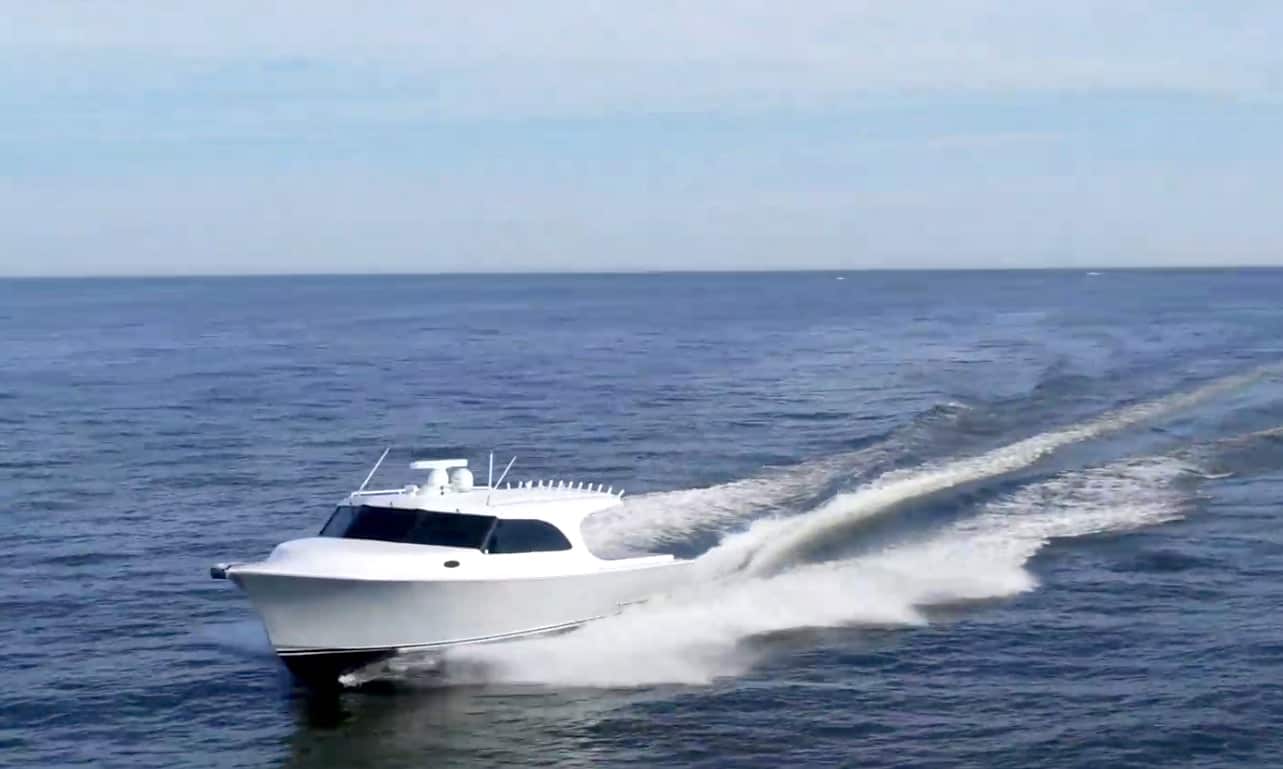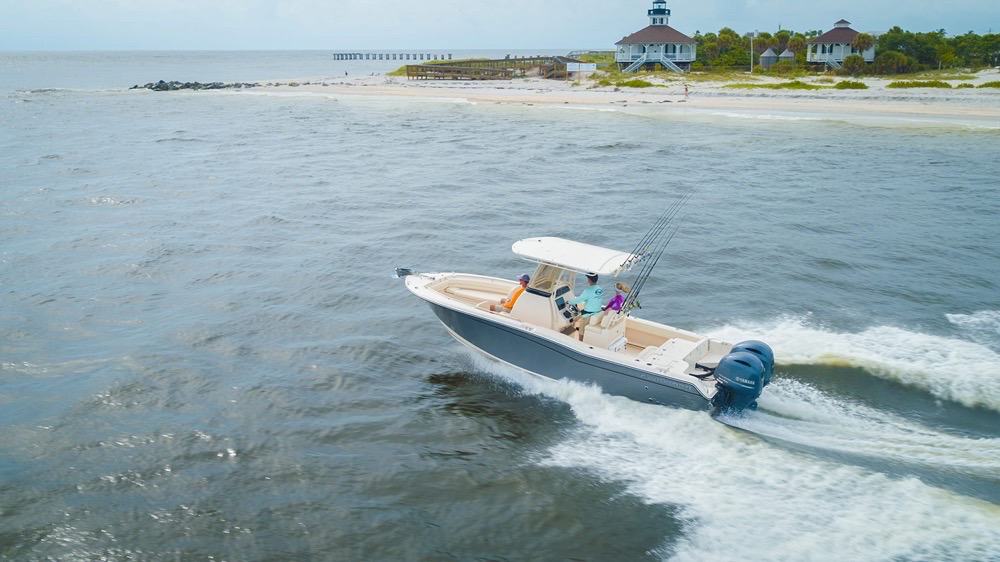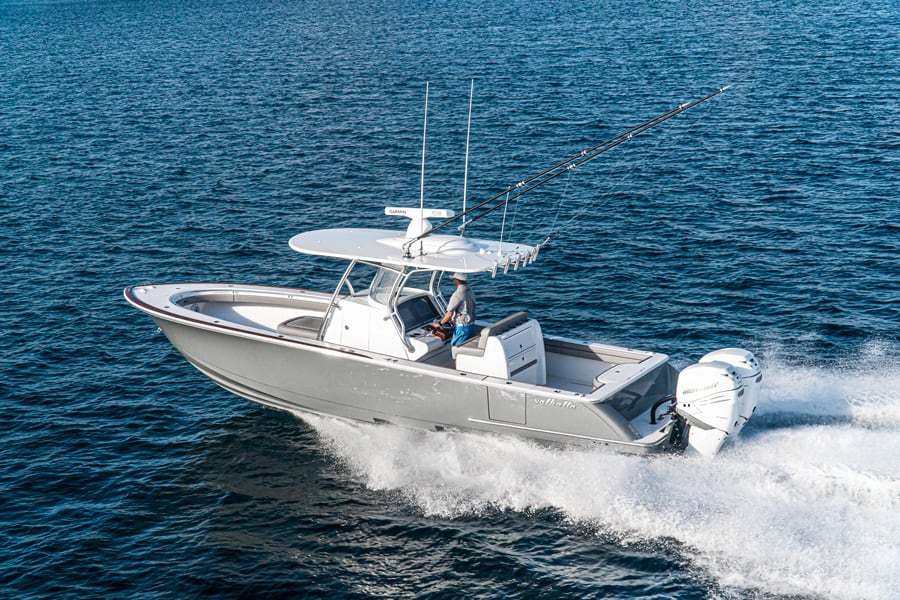Year: 2016
LOA: 19’4″
Beam: 8’2″
Draft: 14″ (engine up)
Weight: 2,360 lb
Deadrise: 14.5 °
Fuel: 52 gal
Capacity: 8
Power range: 150–200 hp
Base Price: $58,800
Contact: www.gradywhite.com
A friend who is a veteran boating writer likes to talk about “big little boats,” water-borne sail and power over-achievers that offer high value in seaworthiness, safety and utility for their size. Grady-White has a worthy new addition to the list, the 191 CE (Coastal Explorer). The fact that it has head-turning good looks doesn’t hurt, either.
It’s as roomy as a 19-footer gets, but its Hunt-designed SeaV2 hull keeps it riding soft and dry even in short, steep seas. The ingenious variable-deadrise running bottom has moderate deadrise (14.5 degrees) in the aft half that sharpens smoothly to a wave-cleaving bow entry, with bottom strakes, reversed chines and graceful Carolina flare in the bow to knock down spray. The raised sheerline in the forward half of the hull complements the flare nicely from both aesthetic and seakeeping points of view. We saw the design at work on a long test ride down the James River from Richmond well past Hopewell with dealer Mickey Brown of Southeastern Marine. The windshield stayed bone-dry over thirty miles, while the boat threw spray well out to the side. The hull came up onto plane easily without (optional) trim tabs, though they would be useful for fine-tuning trim on truly nasty days in the open Bay.

Yamaha’s F150 four-stroke outboard, another overachiever in power, durability and efficiency, balances the 191 CE well, giving a top speed of 40.3 knots. Best efficiency came at 3500–4000 rpm, with speeds in the 20- to 25-knot range and fuel burn of 5.3–6.7 gallons per hour, yielding a range at 90 percent of capacity around 180 miles. That adds up to a lot of fishing, day-cruising and tow sports.
And Grady-White has created the 191 CE purposefully to serve all three of those missions. Remember that bow flare? It makes her unusually spacious for her length, and Grady-White’s design/engineering team has taken ingenious advantage of it. Fishing? The flare allows placement of a broad platform for casting and throwing a cast net. The small bulkhead at the front holds a wiring panel for a bow-mount electric motor. Beneath on the centerline is a huge fish/storage box, with an anchor/rode locker cleverly molded into the starboard side. A small scallop in the lid allows for the line to run through with pull-up cleats on either side of the bow to fasten it.
Another thoughtful touch is a pair of steps at the aft end of the bow deck, port and starboard, for easy access. Sun pad? Of course. Just snap on the full set of cushions. But wait. Fit optional backrests onto the after ends of the deck to convert them to lounges. Want more? A table on an adjustable pedestal can either connect the bow deck to the seat in front of the console, lengthening the center of the deck to a remarkable seven feet, or rise to become a picnic table to serve everyone around the bow. The console seat, by the way, holds a cooler that converts easily to a livewell. On either side is a pair of vertical rod holders.
Similarly, the stern deck serves casters well. Hinged lids on either side lift to reveal jump seats, with handy grab rails and beverage holders on the gunwales. And the same detachable backrests that fit the bow lounges work here (a good reason to buy a second pair). That stern deck can also fit a detachable ski pylon for towing toys. The aft backside of the stern deck to port lifts up to reveal a telescoping swim ladder. Under the jump seats are storage trays that lift out to reveal the starting battery and switch (to starboard) and access to through-hulls and pumps (to port). In the center of the stern deck is another insulated box that works as a cooler or another livewell.

The console provides a compact helm with Yamaha gauges, a switch panel and space for a flush-mounted electronic display. There is good storage beneath, including space for a battery to feed the bow-mount electric motor. A T-top is available, though its air resistance will bleed some speed from the top end (with a T-top and a desire for tow sports, it’s worth considering the optional Yamaha F200, which is basically the same weight as the F150).
The helm seat is a comfortable leaning post with a removable backrest. It offers a fold-down footrest for long runs and holds a carry-on 72-quart cooler beneath. Remove the seat back, and the two cylinders that hold it at either side become additional rod holders. With four vertical rod holders in the gunwales, the total becomes ten. If you need more, consider the T-top, which holds four on the after edge, and if you need mounts for fly rods, hang a pair fore-and-aft under each side to the top.
Finally, consider the high quality standards of this brand. Watch a video of the boat running and notice how cleanly the bottom strakes and chines deflect spray. That capacity results not only from the Hunt SeaV2 design but the care exercised by the lamination crew to make sure the finished product follows the design. That kind of care extends to the sturdy hatches, which lie precisely in deep channels that catch rainwater and spray (if any) before it can go into the compartment below and drain it to the self-bailing cockpit. The hinges that articulate those hatches are high-grade stainless steel, with stainless shocks to keep them up. The mounts for the shocks are through-bolted to small, smooth backing plates. All of the rod-holders and cup-holders have drains that lead not to the bilge but to the cockpit, where water runs to the scuppers and overboard.
The Grady-White 191 Coastal Explorer is a good-looking, versatile, seaworthy, “big little boat” that can handle any Chesapeake conditions a prudent skipper would take it out in, from tidal rivers to the Bridge-Tunnel between the Virginia Capes. It’s easy to tow and launch, and it’s built to last. That is a high-value combination!
by John Page Williams



